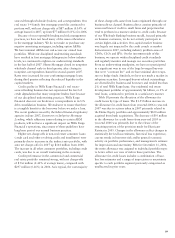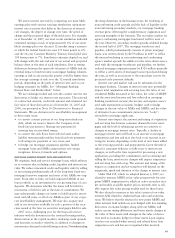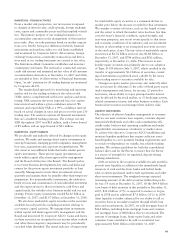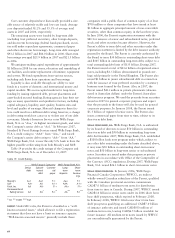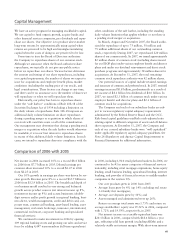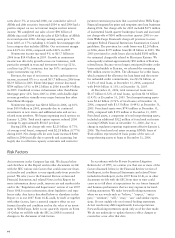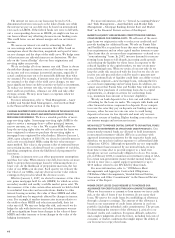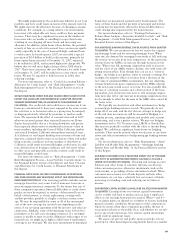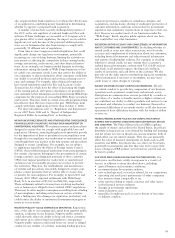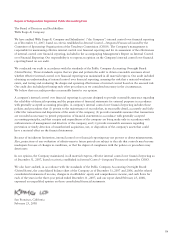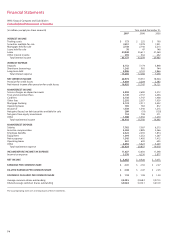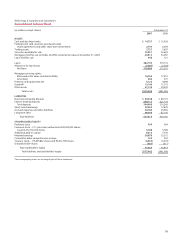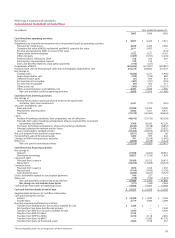Wells Fargo 2007 Annual Report Download - page 70
Download and view the complete annual report
Please find page 70 of the 2007 Wells Fargo annual report below. You can navigate through the pages in the report by either clicking on the pages listed below, or by using the keyword search tool below to find specific information within the annual report.67
In this Report we make forward-looking statements that we
expect or believe:
• net charge-offs will be higher in 2008, particularly in the
Home Equity portfolio;
• there is minimal additional loss content in nonaccrual loans;
• the provision for credit losses for consumer loans, absent a
significant credit event, severe decrease in collateral values,
significant acceleration of losses or significant change in
payment behavior, will closely track the level of related
net charge-offs;
• FIN 48 will cause more volatility in our effective tax rate
from quarter to quarter;
• our investments in affordable housing and sustainable energy
projects will be recovered over time through realization of
federal tax credits;
• the amount of any additional consideration that may be
payable in connection with previous acquisitions will not
be significant to our financial statements;
• the amount of nonaccrual loans will change due to portfolio
growth, portfolio seasoning, routine problem loan recognition
and resolution through collections, sales or charge-offs;
• recent guidance issued by federal financial regulatory agencies
for nonprime mortgage lending will not have a significant
impact on Wells Fargo Financial’s operations;
• the election to measure at fair value new prime residential
MHFS and other interests held will reduce certain timing
differences and better match changes in the value of these
assets with changes in the value of derivatives used as
economic hedges for these assets;
• changes in the fair value of derivative financial instruments
used as economic hedges of derivative loan commitments
will fully or partially offset changes in the fair value of such
commitments to the extent changes in value are due to
interest rate changes;
• capital expenditures of approximately $1 billion will be made
in 2008 for our stores, relocation and remodeling of our
facilities, and routine replacement of furniture, equipment
and servers;
• proceeds of securities issued in the future will be used for
general corporate purposes;
• the outcome of pending and threatened legal actions will not
have a material adverse effect on our results of operations or
stockholders’ equity;
• $63 million of net deferred gains on derivatives in other
comprehensive income at December 31, 2007, will be
reclassified as earnings in the next 12 months;
• $126 million of unrecognized compensation cost related to
stock options will be recognized over a weighted-average
period of 2.1 years;
• a contribution to the Cash Balance Plan will not be required
in 2008; and
• our unrecognized tax benefits could decrease by approximately
$100 to $200 million during the next 12 months primarily
related to statute expirations.
This Report also includes various statements about the esti-
mated impact on our earnings from simulated changes in inter-
est rates and on expected losses in our loan portfolio from
assumed changes in loan credit quality. As described in more
detail below and elsewhere in this Report, changes in the esti-
mate of the allowance for credit losses and the related provision
expense could have a material negative effect on net income.
OUR ABILITY TO GROW REVENUE AND EARNINGS WILL SUFFER IF WE
ARE UNABLE TO CROSS-SELL MORE PRODUCTS TO CUSTOMERS. Selling
more products to our customers—“cross-selling”—is the foun-
dation of our business model and key to our ability to grow
revenue and earnings. Many of our competitors also focus on
cross-selling, especially in retail banking and mortgage lending.
This can put pressure on us to sell our products at lower prices,
reducing our net interest income and revenue from our fee-based
products. It could also affect our ability to keep existing customers.
New technologies could require us to spend more to modify or
adapt our products to attract and retain customers. Increasing
our cross-sell ratio— or the average number of products sold to
existing customers— may become more challenging, especially
given that our cross-sell ratio is already high, and we might not
attain our goal of selling an average of eight products to each
customer.
AN ECONOMIC RECESSION OR EVEN A MODEST SLOWDOWN COULD
REDUCE DEMAND FOR OUR PRODUCTS AND SERVICES AND LEAD TO
LOWER REVENUE AND LOWER EARNINGS. We earn revenue from the
interest and fees we charge on the loans and other products and
services we sell. When the economy slows, the demand for those
products and services can fall, reducing our interest and fee
income and our earnings. An economic downturn can also hurt
the ability of our borrowers to repay their loans, causing us to
incur higher credit losses. Several factors could cause the economy
to slow down or even recede, including higher energy costs,
higher interest rates, reduced consumer or corporate spending,
a slowdown in housing, declining home values, natural disasters,
terrorist activities, military conflicts, and the normal cyclical
nature of the economy.
CHANGES IN STOCK MARKET PRICES COULD REDUCE FEE INCOME FROM
OUR BROKERAGE AND ASSET MANAGEMENT BUSINESSES. We earn fee
income from managing assets for others and providing broker-
age services. Because investment management fees are often
based on the value of assets under management, a fall in the
market prices of those assets could reduce our fee income.
Changes in stock market prices could affect the trading activity
of investors, reducing commissions and other fees we earn from
our brokerage business.
For more information, refer to “Risk Management –
Asset/Liability and Market Risk Management – Market Risk –
Equity Markets” in the Financial Review section of this Report.
CHANGES IN INTEREST RATES COULD REDUCE OUR NET INTEREST
INCOME AND EARNINGS. Our net interest income is the interest we
earn on loans, debt securities and other assets we hold less the
interest we pay on our deposits, long-term and short-term debt,
and other liabilities. Net interest income is a measure of both
our net interest margin— the difference between the yield we
earn on our assets and the interest rate we pay for deposits and
our other sources of funding— and the amount of earning assets
we hold. As a result, changes in either our net interest margin or
the amount of earning assets we hold could affect our net inter-
est income and our earnings.
Changes in interest rates— up or down—could adversely
affect our net interest margin. Although the yield we earn on
our assets and our funding costs tend to move in the same direc-
tion in response to changes in interest rates, one can rise or fall
faster than the other, causing our net interest margin to expand
or contract. Our liabilities tend to be shorter in duration than
our assets, so they may adjust faster in response to changes in
interest rates. As a result, when interest rates rise, our funding
costs may rise faster than the yield we earn on our assets, caus-
ing our net interest margin to contract until the yield catches up.
Changes in the slope of the “yield curve”—or the spread
between short-term and long-term interest rates— could also
reduce our net interest margin. Normally, the yield curve is
upward sloping, meaning short-term rates are lower than long-
term rates. Because our liabilities tend to be shorter in duration
than our assets, when the yield curve flattens or even inverts,
we could experience pressure on our net interest margin as
our cost of funds increases relative to the yield we can earn
on our assets.




